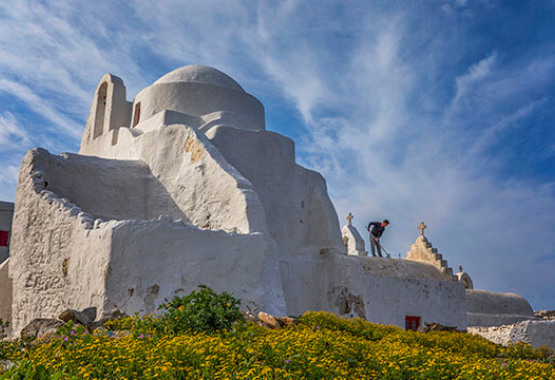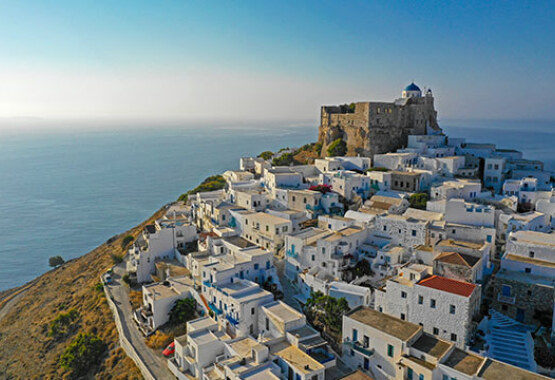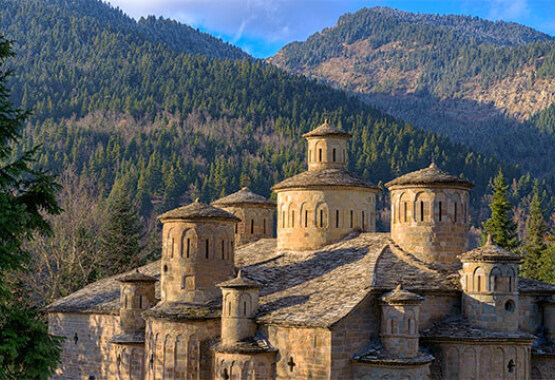UNESCO Monuments in the Peloponnese
Significant monuments such as archaeological sites, Byzantine churches and impressive castles, dating to various historical periods, make the Peloponnese the ideal place for the visitor to get acquainted with the history and culture of Greece. It’s worth noting that 5 out of 20 UNESCO Monuments in Greece are located in the Peloponnese.
Let’s visit them.
Temple of Apollo Epicurius
The temple of Apollo Epicurius lies at an elevation of 1,130 metres in Vasses (known in antiquity as Figaleia), in the heart of the Peloponnese. The temple is also known as the Parthenon of the Peloponnese as Ictinus, the great ancient Greek architect who designed and constructed it, has also designed the Parthenon in Athens with Kallikrates. This world-renowned architectural gem was the first among the great monuments of Greece to be included in UNESCO’s World Heritage Site List in 1986. You can reach the temple driving through Ilia region, following a fascinating route along the banks of Neda river, or travel from Tripoli and Megalopolis.
The original temple dates back to the 7th century BC, yet it took its current form around 420-400 BC. The newer structure encapsulates all the architectural expertise of the ancient Greek civilisation. The temple bears archaic as well as novel at that time architectural elements and over the centuries tourists have been impressed and drawn by its beauty.
Sanctuary of Asklepios at Epidaurus
Epidaurus is one of the most important ancient archaeological sites reflecting the splendour of the Greek culture, through its imposing beauty. The ancient town stands on the land of Argolida, overlooking the Saronic Gulf. The mountains Arachnaio, Koryfaio and Tithio embraced the ancient town and protected it against strong winds, endowing it with a very mild climate. Gurgling sparkling waterways, beautiful natural landscapes and the beneficial climate served to create the ideal location for engaging in man-healing practices with the help of the Gods. This is where Asklepieion was founded; it served as the main practice area for the Healer god of Greek antiquity and it was the most important healing centre of the entire Greek and Roman world. The monuments in the site are not only considered as ancient greek art masterpieces, known across the world, they also offer very useful information on the ancient greek medical practice.
It is said that there were more than 200 such healing centres throughout the Eastern Mediterranean area.
Mystras
Visit the medieval fortified town of Mystras in the Peloponnese located 6km NW of Sparta and let yourself be captivated by this destination’s byzantine splendour.
Wander in the site and feel the magic of its medieval grandeur: the Palaces for the Royal House of Palaiologos, the Houses of noblemen Laskaris and Frangopoulos, beautiful churches (Saint Dimitrios and Pantanassa), impressive Monasteries (Perivleptos and Vrontochio). Visit the Archaeological Museum, housed in a 1754 stone built structure. This is the best way to complete your tour of one of the world’s most impressive archaeological sites.
Olympia Archaeological Site
The most significant sanctuary of ancient Greece, dedicated to Zeus, the father of the ancient Greek gods, lies in the western Peloponnese. It is located in a green landscape, in the valley of Alpheios river, southwest at the foot of Mount Kronios, at the confluence of Alpheios and Kladeos Rivers.
Olympia became the most significant religious and athletic centre in Greece. It is famous as the location for the Olympic Games, which were held every four years to honour Zeus, the king of gods.
According to UNESCO’s World Heritage website, there is probably no ancient archaeological site anywhere around the world more related to today’s world than Olympia. The stadium of Olympia where the ancient Olympic Games were held, the impressive proportions of the temple of Zeus, being the largest temple in the Peloponnese, the temple of Hera, Philippeio and Palaestra (Gymnasium) are the site’s most significant attractions.
Mycenae and Tiryns
The Peloponnesian land has nurtured one of the most important civilisations known in this area since the dawn of history: the Mycenaean civilisation.
The apogee of the Mycenaean people is dated back to the Late Bronze Age, between 1350 and 1200 BC. Their architecture, monuments and culture were majestic. The first clans were formed as early as 1700 BC and first tombs date approximately to that same period. The Palace complexes, the Cyclopean fortifications, the famous "Tomb (Treasury) of king Atreus”, huge arched doors, fountains and ramparts are considered to be among the greatest architectural complexes known from the ancient world.
The fortification on the hill of Tiryns (at 8-km distance from Argos town) protected the palace complex. It is believed that ancient Greeks could not accept the fact that it was built by humans as it was truly an impressive construction. Keep in mind that great heroes with supernatural powers have been associated with Tiryns: Bellerophon, Perseus, and Hercules.
The towering circular building on the hilltop -27 metres in diameter- bears witness to Tiryns’ once dominant power. The town’s fortifications were built in stages, for the protection of the palatial complex, the places of worship and burial sites. Warehouses, workshops and residences provide the complete picture of a city that flourished for almost 2000 years, until the 5th century BC.





